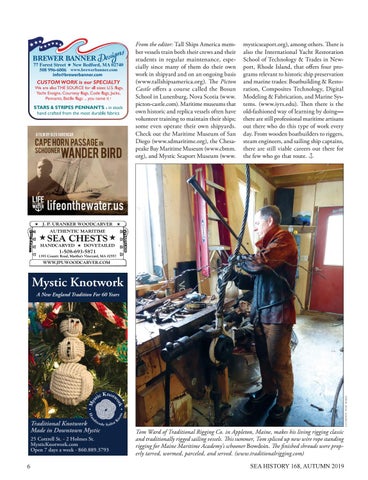1/8 page AD
From the editor: Tall Ships America member vessels train both their crews and their students in regular maintenance, especially since many of them do their own work in shipyard and on an ongoing basis (www.tallshipsamerica.org). The Picton Castle offers a course called the Bosun School in Lunenburg, Nova Scotia (www. picton-castle.com). Maritime museums that own historic and replica vessels often have volunteer training to maintain their ships; some even operate their own shipyards. Check out the Maritime Museum of San Diego (www.sdmaritime.org), the Chesapeake Bay Maritime Museum (www.cbmm. org), and Mystic Seaport Museum (www.
mysticseaport.org), among others. There is also the International Yacht Restoration School of Technology & Trades in Newport, Rhode Island, that offers four programs relevant to historic ship preservation and marine trades: Boatbuilding & Restoration, Composites Technology, Digital Modeling & Fabrication, and Marine Systems. (www.iyrs.edu). Then there is the old-fashioned way of learning by doing— there are still professional maritime artisans out there who do this type of work every day. From wooden boatbuilders to riggers, steam engineers, and sailing ship captains, there are still viable careers out there for the few who go that route.
Mystic Knotwork
Traditional Knotwork Made in Downtown Mystic 25 Cottrell St. - 2 Holmes St. MysticKnotwork.com Open 7 days a week - 860.889.3793
6
courtesy tom ward
A New England Tradition For 60 Years
Tom Ward of Traditional Rigging Co. in Appleton, Maine, makes his living rigging classic and traditionally rigged sailing vessels. This summer, Tom spliced up new wire rope standing rigging for Maine Maritime Academy’s schooner Bowdoin. The finished shrouds were properly tarred, wormed, parceled, and served. (www.traditionalrigging.com) SEA HISTORY 168, AUTUMN 2019
